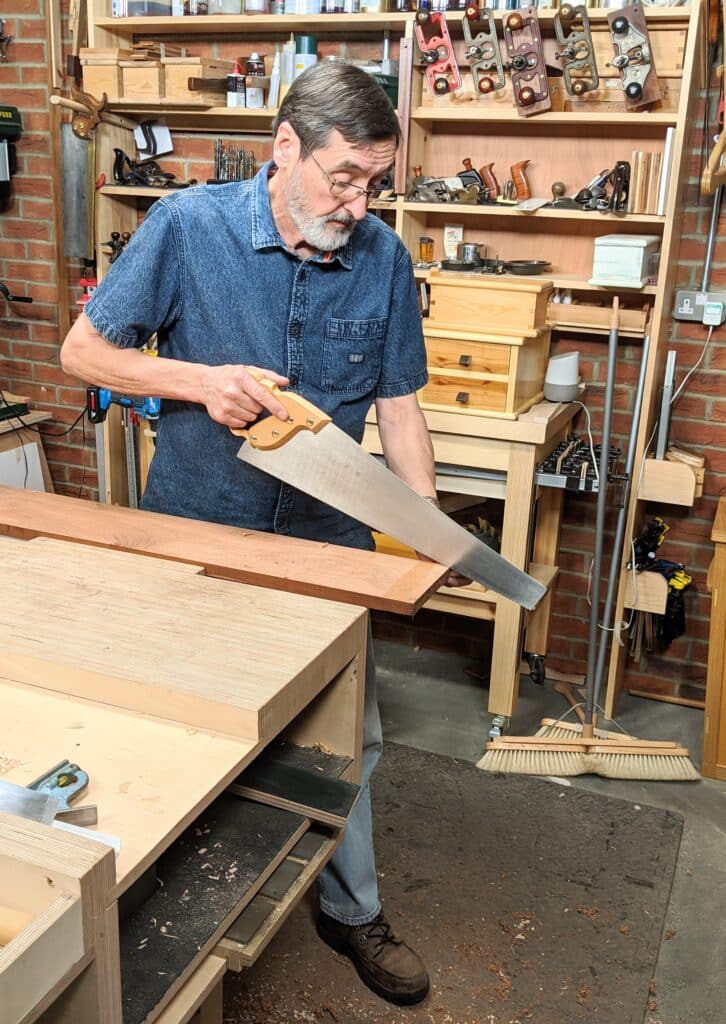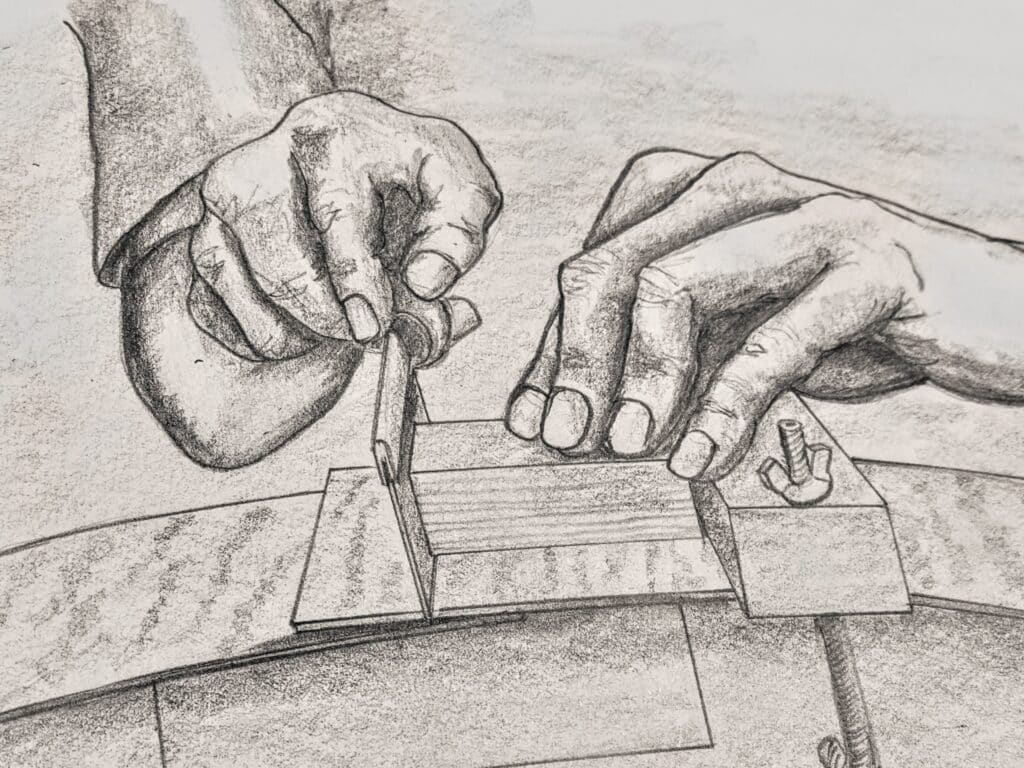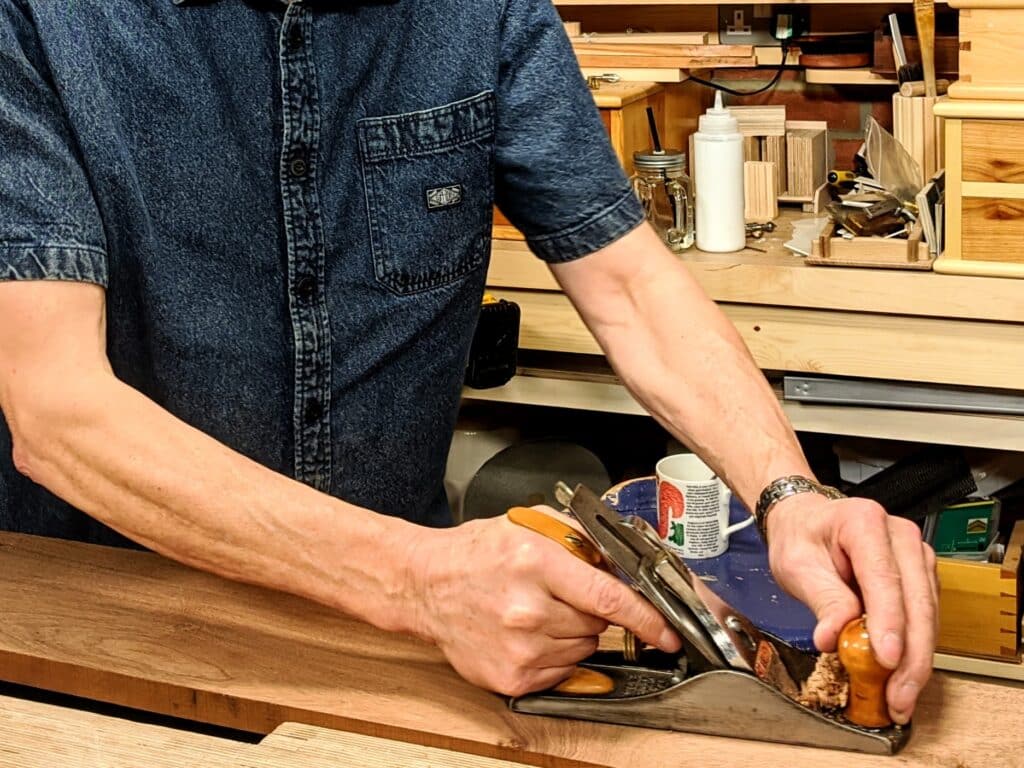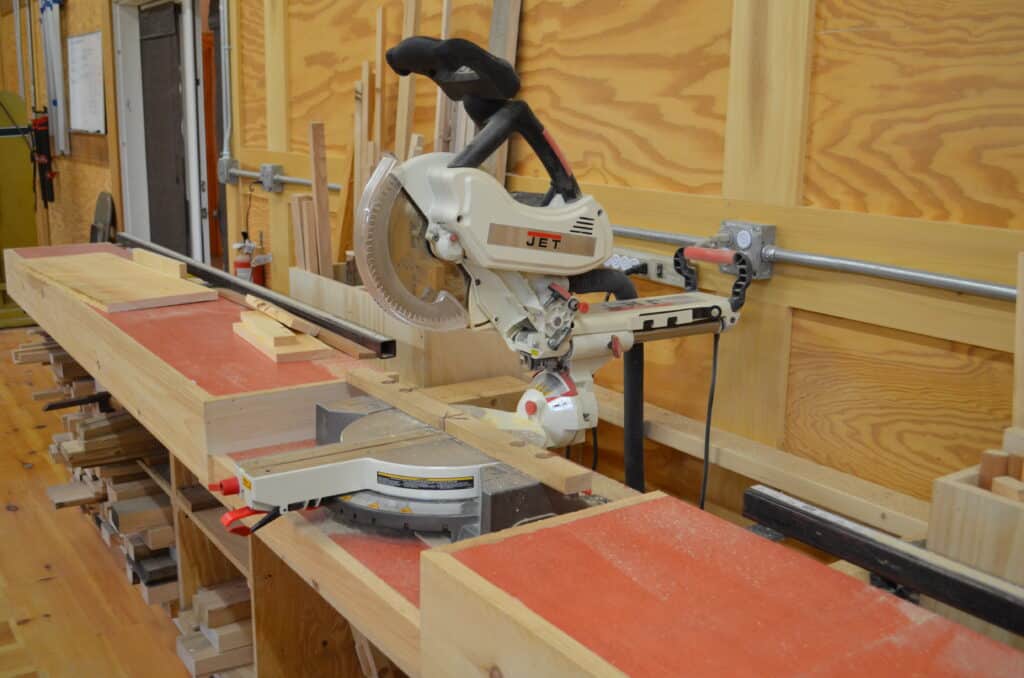Relaxing Your Future
I relax into most of the cuts, let the weight of my arms and the tool work ahead of me. My task guides, adjusts after withdrawals from thrusting cuts readies reengagement cut on cut. Two hundred saw thrusts take but minutes with two hundred withdrawals matched equally in number and power. I realign and engage to push forward and cut more. I do this on and off throughout the days. Who can know the number of cuts in 58 years as a maker.
I dwell on the reductive process woodworking always follows. The start-work is the tree and the end result a thousand sections cut from its severed stem. Woodworkers new to hand tools seem often to have control issues they must one day resolve if they are to become what they want to be. Learning not to use force can be hard. The very thing that causes a saw to curve from the line is often excessive force yet they believe ot takes force to effect each stroke to follow a line. They apply more force as the drift progresses away from the line: the last thing my woodworking needs any of.
Patience to can be lacking. Instead of enjoying the cut’s stroke on stroke passage into the wood they somehow want it to be over. They see progress amiss when progress equals faster speed and distance. Adding force and speed to them seems a good answer. Side by side they take twice as long as the experienced man who’s mastered the craft and accepts every process as a form of meditative multidimensional engagement. On the one side, there seems great peace in the work, on the other a frenetic disconnect. George’s voice comes low and calm, an even influence to roll in with its stilling metre (meter USA) each time I see a person using excessive force at higher speed that disallows the peace of accuracy and thoughtfulness. This is my foundation stone of truth. Craft, all craft, relies on this truth to undergird all that they do.

When George taught me to saw and plane I listened with a heart of care. This too is a bedrock. It seemed unnatural to me not to have a full-fisted grip and to point my forefinger on the tools, but I listened and followed instruction until I owned it. Many years later I saw the universality of his instruction. Those I met from or on different continents pointed the forefinger and passed only three fingers through the handle. The uninformed never do. This showed the pure power of word-of-mouth, passing the methods on to future artisans. For me, it proved a remarkable man-to-boy transfer of craft. It’s not gender specific, I only know one woman woodworker well enough to consider. I never see women in woodworking even though its a craft there to be readily had.

Relaxing and easing into the cuts is a different and separate issue even though the two seem connected by the task. Defining the power of the saw hold as less of a fisted grab and more of a firm grip only tells us how the hand engages the saw with a type of accuracy that translates into both accuracy of cut alignment and then too pressures according to feedback from the wood through the tools as they perform their cuts. These things are not written of. To deny the writing of them and the speaking of them is to deny or at least perhaps fail a next generation by undiscussed detail. Relaxing in the cuts is a more difficult consideration and concept to convey because the watcher cannot see how the hand, body and brain are working and what energy is being expended in terms of effort and direction. The relaxed hand moves a saw that more simply encourages the saw into and through each cut but the relaxed hand in no way means a limp hand There should still be a firmness in the same way we lift an unhandled glass to drink from or lift a small child to our shoulders. My confident cuts can be mistakenly translated by others in the minds as something fast and strong with rapidly repeated manoeuvres. In reality, it’s quite simply the expressed confidence that comes with any mastery that requires repeated moves in succession; any expert always delivers his hand work accurately and with delivery. I don’t ever use my tools for speed. I simply do it quickly because early on in any task at the bench I always establish a rhythm that matches my body and that then establishes synchronised power in a measured and controllable way.

As a young man in my apprenticeship, I watched men without a square cross-cut wood dead square in both directions and time and time again. They were relaxed about it, expected squareness and it always seemed quite effortless. They were working in two realms — effort expended and accuracy. These two elements always worked in tandem. No one used a Skilsaw with a speed-square. They were on their way but had not yet arrived. The speed square replaced the intuitive and the electric power the energy. Line up the Skilsaw to the edge of the speed-square, press the trigger and gentle, steady push-feed the saw through. Fast cuts using either method resulted in a coarser end-grain tearing. Just less neatness. In framing out two of my homes when living in the US and then adding additions too, I generally relied on the Skilsaw and the speed-square. Not for everything, just mostly. One method is just about effortless, the other wholly engaging and high demand. Both have their place.

So now I come to a point. Chop saws have very much replaced the Skilsaw and the radial arm saw for most cross-grain cuts but cannot be used for most large sheet materials because of certain limits in reach. No one machine fits all in the same way no one handsaw fits all. To try to compare the two realms is near futile. The hand toolist gets on well enough with about three saws costing £60 for the three via eBay. The machinist will need, well, many times that and it doesn’t end there.
Why this? Hmm!
In my emerged world, life and work is about the composition and integration of both. This is not something most people experience, recognise or even want or can do. In my world, work is the most welcome part of my life and I think that this results from not having to wear an office, the complimentary suit or uniform or the commute: all that I do fits and suits my existing or self-created surroundings, my environment, the greater whole of people I know and care for. I try not to slip in a bum note to my life or the lives of others just on a whim, though mistakes and the unexpected can and do happen. Composition is about consideration, adjustment and the order of all things. Some things rely on minute-by-minute decisions, others are part of a longer term plan. Day-to-day writing is composition of thought, I write many times a day and then too I make all day in tandem with writing. At other times I factor into a day time to work on a book that discounts too much intrusion or interaction. By this I can compose both myself, my day and my working. I set realistic goals for myself and usually work to them. This is order. Without goals, we achieve only sparodic and mild success, we rarely achieve what we do with some preset goals. The goals don’t have to be rigid legalisms, just self disciplined. Through recent decades, I have striven to recompose and regenerate my life differently. By doing that, others too have nudged their own lives and worked to define and rework theirs. I think we are probably talking a few hundred thousand here. The simple act of building a shed for woodworking, gathering a few tools for them becomes a part of recomposing who they are or want to become. Sweeping the shavings from the workbench and the floor gives opportunity for thoughtful planning of the next task — this too is composition. Simply standing in the middle of a shop in some ephemeral condition is not usually as fruitful as when your cleaning and clearing in the physical. That’s my experience at least. In simple tasks we somehow release ourselves to compose, plan and prepare things future — this too is active composition!
Emerging is a part of the process by which we become conditioned and trained to take our part in the future and the power of culture changes and transforms us to become compliant to the status quo. This tends to be more a conforming rather than a composition. A major wonder in all of life is the composition of every element of life. Aristotle coined the phase “Nature abhors a vacuum.” Science may well have proved there to be exceptions to that rule but as a maxim for living it is true that the phrase simply expresses the idea that unfilled spaces go against the laws of nature and physics and in our world as designers and makers every space needs filling with ideas first and then the making of ideas according to our ideas. This is composition.
It was my parents and George who encouraged me to take total responsibility for my life. This translates into self


So Paul, Are you ever going to write your book about George, What and how he taught you, and the daily experiences you had while working by his side? It sure would be an enjoyable read, especially on a cold winter day.
All the best.
Jim Light, Goshen, Ohio USA
The hurrier I go the behinder I get.
It took me along time to learn that pushing harder does not equal faster and it never equals better.
Thanks Paul! This article I think is one of your best.
I’ll second that’ Tom!
Thank you Paul. In the early 1990s my brother had taken flying lessons. When I was on break, he took my up in a little Cesna. I enjoyed it mostly. At one point there was a fair bit of wind/turbalance. I noticed how lightly he was holding whatever the call the steering wheel in a plane. I commented something to the effect of “don’t you think you should hold that more firmly given how windy it is?” He told me that he had been instructed to have a light hold so that he didn’t oversteer the plane. Apparently, the lightness of touch is used in flying small planes as well for likely similar reasons.
This seems to me very close to what my piano teacher is trying to teach me. If all of my wrist, arm and shoulder muscles are tensed and contracted when I play and even more, then most of the energy I spend is fruitless and will never translate into music. Even worse, this tension would disconnect me from the feel I should get from my fingers in relation with the keys, the feel that would allow me to play with accuracy, nuance, emotion, etc.
And in the same way as you say that you are in fact quicker sawing the way yo do it, Paul, I realise that my teachers arm is free from this tension, seems not that strong and yet she is able to produce a sound way deeper and stronger than what I can do, effortlessly.
Being able to reach that state is not that easy to me though… be it in piano or woodworking. Praticing on simple things helps, but it also seems that practicing while always trying to be aware of the sensations you get from your body, the need to relax, the feedback from the saw or keyboard, and cultivate from that more than simply trying to automatically repeat the same move or scheme is needed.
Yes, there are many facets of life in which this advice applies. As a fellow pianist your example resonates with me (excuse the pun). Anyone who has swung a golf club will also know how unhelpful it is to grip it like a strangler. Runners too have to learn how not to clench muscles that aren’t helping to move them forward.
Any time we need to exert our bodies on the outside world to achieve something – music, sport, woodwork, etc – we will be more effective if we don’t fight against our own selves in the process.
Just … Thank you for sharing your knowledge, it is both enlightening and enjoyable. I am a Daimler and canvas worker but I enjoy woodworking as a hobby.
This weekend I progressed in my workbench build to where I was ready to cut my workbench top to length. It is about 13 inches wide by 3-1/4″ thick of laminated construction lumber. Trying to remember everything I have learned from your teaching, plus some of the other channels I watched. I made my knife wall and just concentrated on following the lines and letting the saw work without using force. Imagine my delight when the result was the two most square cuts I have ever made. Each end was trimmed down and is something I am proud to be able to look at and say, “I did that!”
No fighting the tools, just letting them do what they were designed to do with some gentle nudges at the start to set them on the correct path. I could tell I used my muscles to do the work, in much the same was as using a bit and brace, but it wasn’t exhausting work. It is work that is sustainable throughout a long work session with only minimal breaks. The techniques passed down by the masters of the craft work and hopefully we can become masters and pass them down to those that follow.
Thank you Paul.
It goes without saying (well, up until now) that this efficiency in task and energy investment is only ever possible with properly tuned, sharp hand tools.
I recall the maxim I’ve “read somewhere” (voiced down from a certain George, I think): “Sharpen up, boy!” – I wrote that one right across my workbench, so any times I raise my eyes (in exasperation, or for inspiration?!) I face it.
I’ve sharpen three saws so far, at the same day, trying to follow the same exact steps. One is the very best saw I’ve used to date, cuts like a laser. Another is okay, and the third one mostly sands the wood rather than cut it (guess the first was pure luck).
Instinctively, I use the first lightly and respectfully …I also instinctively put the 3rd saw back half the times I hold it, and regret insisting on it the other half
I guess I’ll have to sharpen ‘em up soon and THEN take it easy 😉